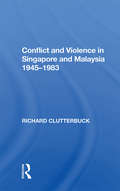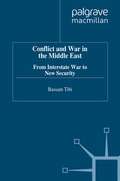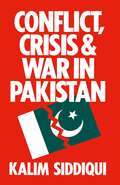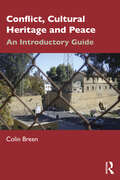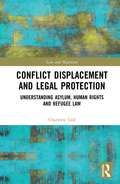- Table View
- List View
Conflict And Violence In Singapore And Malaysia, 1945-1983
by Richard ClutterbuckIs there a risk that Malaysia's racial mixture and its weighted political and economic structures could again explode into the kind of violence which, in 1969, was only just prevented from setting the whole country on fire? And has Singapore's success been bought at a price in civil liberties too high for its health in the future? Four years of th
Conflict And Violence In Singapore And Malaysia, 1945-1983
by Richard ClutterbuckIs there a risk that Malaysia's racial mixture and its weighted political and economic structures could again explode into the kind of violence which, in 1969, was only just prevented from setting the whole country on fire? And has Singapore's success been bought at a price in civil liberties too high for its health in the future? Four years of th
Conflict and War in the Middle East: From Interstate War to New Security
by Bassam TibiFew studies of Middle East wars go beyond a narrative of events and most tend to impose on this subject the rigid scheme of superpower competition. The Gulf War of 1991, however, challenges this view of the Middle East as an extension of the global conflict. The failure of the accord of both superpowers to avoid war even once regional superpower competition in the Middle East had ceased must give rise to the question: Do regional conflicts have their own dynamic? Working from this assumption, the book examines local-regional constraints of Middle East conflict and how, through escalation and the involvement of extra-regional powers, such conflicts acquire an international dimension. The theory of a regional subsystem is employed as a framework for conceptualising this interplay between regional and international factors in Tibi's examination of the Middle East wars in the period 1967-91. Tibi also provides an outlook into the future of conflict in the Middle East in the aftermath of the most recent Gulf War.
Conflict and Youth Rights in India: Engagement and Identity in the North East
by Haans J. FreddyThis book examines how conflict has affected the rights of youth in Northeast India. Examining youth engagement in protracted conflict and its impact on youth rights, the author considers the complex issues besieging the region, including armed insurgency, conflicts between ethnic groups, human rights violations, poor governance and a lack of economic development, all factors contributing to the lack of growth in the region, and a consequent sense of alienation from the Indian mainstream. Moving beyond considering Northeast India as a theatre of insurgency, this pivot offers an alternative understanding of youth unrest in India and issues of non-representation in terms of rights and ethnic, national and cultural identities.
Conflict and Youth Rights in India: Engagement and Identity in the North East
by Haans J. FreddyThis book examines how conflict has affected the rights of youth in Northeast India. Examining youth engagement in protracted conflict and its impact on youth rights, the author considers the complex issues besieging the region, including armed insurgency, conflicts between ethnic groups, human rights violations, poor governance and a lack of economic development, all factors contributing to the lack of growth in the region, and a consequent sense of alienation from the Indian mainstream. Moving beyond considering Northeast India as a theatre of insurgency, this pivot offers an alternative understanding of youth unrest in India and issues of non-representation in terms of rights and ethnic, national and cultural identities.
Conflict, Co-operation and the Rhetoric of Coalition Government (Rhetoric, Politics and Society)
by Judi AtkinsThrough a rhetorical analysis, this book explores how the parties in a coalition government create a united public front while preserving their distinct identities. After proposing an original framework based on the ‘new rhetoric’ of Kenneth Burke, the author charts the path from the inconclusive outcome of the 2010 UK general election and the formation of the Conservative-Liberal Democrat coalition to the dissolution of the partnership in the run-up to May 2015. In doing so, she sheds valuable light on the parties’ use of rhetoric to manage the competing dynamics of unity and distinctiveness in the areas of higher education, constitutional reform, the European Union and foreign policy. This unique and highly-accessible analysis will be of interest to a wide audience, including scholars and students of rhetoric, British politics and coalition studies.
Conflict, Complexity and Mathematical Social Science (Contributions to Conflict Management, Peace Economics and Development #15)
by Gordon Burt Manas Chatterji"Conflict, Complexity and Mathematical Social Science" provides a foundational mathematical approach to the modelling of social conflict. The book illustrates how theory and evidence can be mathematically deepened and how investigations grounded in social choice theory can provide the evidence needed to inform social practice. Countering criticism from constructivist viewpoints it shows how discourse is grounded in mathematical logic and mathematical structure. The modelling of social conflict is viewed as an application of mathematical social science and relevant models are drawn from each field of mathematical psychology, mathematical sociology, mathematical political science and mathematical economics. Unique in its multidisciplinary focus the book brings together powerful mathematical conceptualisations of the social world from a wide range of separate areas of inquiry, thereby providing a strong conceptual framework and an integrated account of social situations. It is a vital resource for all researchers in peace science, peace and conflict studies, politics, international relations, mathematical modelling in the social sciences and complexity theory.
Conflict, Cultural Heritage and Peace: An Introductory Guide
by Colin BreenConflict, Cultural Heritage and Peace offers a series of conceptual and applied frameworks to help understand the role cultural heritage plays within conflict and the potential it has to contribute to positive peacebuilding and sustainable development in post-conflict societies. Designed as a resource guide, this general volume introduces the multiple roles cultural heritage plays through the conflict cycle from its onset, subsequent escalation and through to resolution and recovery. In its broadest sense, it questions what role cultural heritage plays within conflict, how cultural heritage is used in the construction and justification of conflict narratives, how are these narratives framed and often manipulated to support particular perspectives, and how we can develop better understandings of cultural heritage and work towards the better protection of cultural heritage resources during conflict. It moves beyond the protection paradigm and recognises that cultural heritage can contribute to building peace and reconciliation in post-conflict environments. The study offers a conceptual and operational framework to understand the roles cultural heritage plays within conflict cycles, how it can be targeted during war, and the potential cultural heritage has in positive peacebuilding across the conflict lifecycle. Conflict, Cultural Heritage, and Peace offers an invaluable introduction to cultural heritage at all stages in conflict scenarios which will benefit students, researchers and practitioners in the field of heritage, environment, peace and conflict studies.
Conflict, Cultural Heritage and Peace: An Introductory Guide
by Colin BreenConflict, Cultural Heritage and Peace offers a series of conceptual and applied frameworks to help understand the role cultural heritage plays within conflict and the potential it has to contribute to positive peacebuilding and sustainable development in post-conflict societies. Designed as a resource guide, this general volume introduces the multiple roles cultural heritage plays through the conflict cycle from its onset, subsequent escalation and through to resolution and recovery. In its broadest sense, it questions what role cultural heritage plays within conflict, how cultural heritage is used in the construction and justification of conflict narratives, how are these narratives framed and often manipulated to support particular perspectives, and how we can develop better understandings of cultural heritage and work towards the better protection of cultural heritage resources during conflict. It moves beyond the protection paradigm and recognises that cultural heritage can contribute to building peace and reconciliation in post-conflict environments. The study offers a conceptual and operational framework to understand the roles cultural heritage plays within conflict cycles, how it can be targeted during war, and the potential cultural heritage has in positive peacebuilding across the conflict lifecycle. Conflict, Cultural Heritage, and Peace offers an invaluable introduction to cultural heritage at all stages in conflict scenarios which will benefit students, researchers and practitioners in the field of heritage, environment, peace and conflict studies.
Conflict, Culture and Identity in GP Training
by Jennifer L. JohnstonThis book explores the identity work and conflicted perspectives of general practitioner (GP) trainees working in hospitals in the UK. Drawing on empirical and theoretical scholarship, and privileging the analysis of social language-in-use, Johnston describes primary care medicine as a separate paradigm with its own philosophy, identity and practice. Casting primary and secondary care in historical conflict, the perceived lower status of primary care in the world of medicine is explored. Significant identity challenges ensue for GP trainees positioned at the coalface of conflict. Problematising structures of GP training and highlighting how complex historical power dynamics play out in medical training, the author advocates for radical change in how GPs are trained in order to manage the current primary care recruitment and retention crisis.
Conflict, Democratization, and the Kurds in the Middle East: Turkey, Iran, Iraq, and Syria
by David Romano Mehmet GursesIn Turkey, Iran, Iraq, and Syria, central governments historically pursued mono-nationalist ideologies and repressed Kurdish identity. As evidenced by much unrest and a great many Kurdish revolts in all these states since the 1920s, however, the Kurds manifested strong resistance towards ethnic chauvinism. What sorts of authoritarian state policies have Turkey, Iraq, Iran and Syria relied on to contain the Kurds over the years? Can meaningful democratization and liberalization in any of these states occur without a fundamental change vis-à-vis their Kurdish minorities? To what extent does the Kurdish issue function as both a barrier and key to democratization in four of the most important states of the Middle East? While many commentators on the Middle East stress the importance of resolving the Arab-Israeli dispute for achieving 'peace in the Middle East,' this book asks whether or not the often overlooked Kurdish issue may constitute a more important fulcrum for change in the region, especially in light of the 'Arab Spring' and recent changes in Turkey, Iraq, Iran and Syria.
Conflict Displacement and Legal Protection: Understanding Asylum, Human Rights and Refugee Law (Law and Migration)
by Charlotte LülfWhile the 21st century bears witness to several conflicts leading to mass displacement, the conflict in Syria has crystallised the need for a solid legal framework and legal certainty. This book analyses the relevant legal instruments for the provision of a protection status for persons fleeing to Europe from conflict and violence. It focuses on the conceptualisation of conflict and violence in the countries of origin and the different approaches taken in the interpretation of them in the 1951 Refugee Convention, the Recast Qualification Directive of the European Union and the European Convention on Human Rights. It traces the hierarchical order of protection granted, starting with refugee protection status, to subsidiary protection status and finally with the negative protection from non-refoulement. Recent case law and asylum status determination practices of European countries illustrate the obstacles in the interpretation as well as the divergence in the application of the legal instruments. The book fills an important gap in examining the current practices of key actors, including the United Nations High Commissioner for Refugees and European states, tracing changes in national and international policies and revealing discrepancies towards contemporary approaches to conflicts. It refines the interaction and cross-fertilisation of the different relevant fields of European asylum law, human rights law and the laws of armed conflict in order to further the development of a harmonised protection regime for conflict-induced displacement.
Conflict Displacement and Legal Protection: Understanding Asylum, Human Rights and Refugee Law (Law and Migration)
by Charlotte LülfWhile the 21st century bears witness to several conflicts leading to mass displacement, the conflict in Syria has crystallised the need for a solid legal framework and legal certainty. This book analyses the relevant legal instruments for the provision of a protection status for persons fleeing to Europe from conflict and violence. It focuses on the conceptualisation of conflict and violence in the countries of origin and the different approaches taken in the interpretation of them in the 1951 Refugee Convention, the Recast Qualification Directive of the European Union and the European Convention on Human Rights. It traces the hierarchical order of protection granted, starting with refugee protection status, to subsidiary protection status and finally with the negative protection from non-refoulement. Recent case law and asylum status determination practices of European countries illustrate the obstacles in the interpretation as well as the divergence in the application of the legal instruments. The book fills an important gap in examining the current practices of key actors, including the United Nations High Commissioner for Refugees and European states, tracing changes in national and international policies and revealing discrepancies towards contemporary approaches to conflicts. It refines the interaction and cross-fertilisation of the different relevant fields of European asylum law, human rights law and the laws of armed conflict in order to further the development of a harmonised protection regime for conflict-induced displacement.
Conflict, Education and Peace in Nepal: Rebuilding Education for Peace and Development
by Tejendra PheraliIncreasing inequalities, political movements and violent extremism across the world cause social and political instability in which education is enormously implicated. Placed firmly in this wider global context, this volume explores interactions between education and armed conflict during the 'People's War' (1996 – 2006) in Nepal. Building upon theoretical concepts that deal with multifarious links between education and conflict, Tejendra Pherali provides a critical analysis of the contentious role of education in the emergence of conflict, as well as the effects of violence on education. Pherali engages with sociological and political theories to analyse the emergence and expansion of armed rebellion and discuss implications for peacebuilding and social transformation. He argues that education in Nepal played a complicit role in the conflict, primarily benefitting the traditionally privileged social groups in the society and hence, perpetuating the existing structural inequalities, which were the major causes of the rebellion. Schools, trapped in the middle of the conflict between the Maoists and the security forces, became a significant political space that facilitated critical education, providing intellectual strength to the violent rebellion. Exploring education after the conflict, the author argues that the reconstruction should adopt a 'conflict-sensitive' approach to deal with issues concerning educational inequity, social exclusion, and political hegemony of the privileged social groups. The volume provides invaluable insights into post-conflict opportunities and challenges for educational reforms that align with inclusive democracy, social justice and equitable development.
Conflict, Education and Peace in Nepal: Rebuilding Education for Peace and Development
by Tejendra PheraliIncreasing inequalities, political movements and violent extremism across the world cause social and political instability in which education is enormously implicated. Placed firmly in this wider global context, this volume explores interactions between education and armed conflict during the 'People's War' (1996 – 2006) in Nepal. Building upon theoretical concepts that deal with multifarious links between education and conflict, Tejendra Pherali provides a critical analysis of the contentious role of education in the emergence of conflict, as well as the effects of violence on education. Pherali engages with sociological and political theories to analyse the emergence and expansion of armed rebellion and discuss implications for peacebuilding and social transformation. He argues that education in Nepal played a complicit role in the conflict, primarily benefitting the traditionally privileged social groups in the society and hence, perpetuating the existing structural inequalities, which were the major causes of the rebellion. Schools, trapped in the middle of the conflict between the Maoists and the security forces, became a significant political space that facilitated critical education, providing intellectual strength to the violent rebellion. Exploring education after the conflict, the author argues that the reconstruction should adopt a 'conflict-sensitive' approach to deal with issues concerning educational inequity, social exclusion, and political hegemony of the privileged social groups. The volume provides invaluable insights into post-conflict opportunities and challenges for educational reforms that align with inclusive democracy, social justice and equitable development.
Conflict, Education and People's War in Nepal (Nepal and Himalayan Studies)
by Sanjeev RaiThis book presents an overview of the democracy movement and the history of education in Nepal. It shows how schools became the battleground for the state and the Maoists as well as captures emerging trends in the field, challenges for the state and negotiations with political commitments. It looks at the factors that contributed to the conflict, and studies the politics of the region alongside gender and identity dynamics. One of the first studies on the subject, the book highlights how conflict and education are intrinsically linked in Nepal. It illustrates how schools became the centre of attention between warring groups and how they were used for political meetings and recruitment of fighters during the political transitions in a contested terrain in South Asia. It brings to the fore incidents of abduction and killing of teachers and students, and the use of children as porters for arms and ammunitions. Drawing extensively on both primary and secondary sources and qualitative analyses, the book provides the key to a complex web of relationships among the stakeholders during conflict and also models of education in post-conflict situations. This book will interest scholars and researchers in education, politics, peace and conflict studies, sociology, development studies, social work, strategic and security studies, contemporary history, international relations, and Nepal and South Asian studies.
Conflict, Education and People's War in Nepal (Nepal and Himalayan Studies)
by Sanjeev RaiThis book presents an overview of the democracy movement and the history of education in Nepal. It shows how schools became the battleground for the state and the Maoists as well as captures emerging trends in the field, challenges for the state and negotiations with political commitments. It looks at the factors that contributed to the conflict, and studies the politics of the region alongside gender and identity dynamics. One of the first studies on the subject, the book highlights how conflict and education are intrinsically linked in Nepal. It illustrates how schools became the centre of attention between warring groups and how they were used for political meetings and recruitment of fighters during the political transitions in a contested terrain in South Asia. It brings to the fore incidents of abduction and killing of teachers and students, and the use of children as porters for arms and ammunitions. Drawing extensively on both primary and secondary sources and qualitative analyses, the book provides the key to a complex web of relationships among the stakeholders during conflict and also models of education in post-conflict situations. This book will interest scholars and researchers in education, politics, peace and conflict studies, sociology, development studies, social work, strategic and security studies, contemporary history, international relations, and Nepal and South Asian studies.
Conflict, Exclusion and Dissent in the Linguistic Landscape (Language and Globalization)
by Rani Rubdy Selim Ben SaidThis book explores the dynamics of the linguistic landscape as a site of conflict, exclusion, and dissent. It focuses on socio-historical, economic, political and ideological issues, such as reflected in mass protest demonstrations, to forge links between landscape, identity, social justice and power.
Conflict Hot Spots: Emergence, Causes and Consequences
by Alex BraithwaiteMilitarized conflicts between states appear to occur repeatedly in the same geographic regions. Both World Wars and a series of interstate disputes in the post-Cold War system had their origins in the Balkans region of Eastern Europe. This study introduces the concept of a conflict hot spot to the broader empirical literature on conflict processes. It devotes considerable time to identifying the common causes and consequences of conflict hot spots across many regions globally, offering a theoretical and empirical contribution to the emerging literature on the spatiality of conflict processes. Rather than merely controlling for spatial dependence between episodes of conflict, the book incorporates this spatial dependence within a series of models of conflict behaviours and is, therefore, able to directly model the process of conflict diffusion.
Conflict Hot Spots: Emergence, Causes and Consequences
by Alex BraithwaiteMilitarized conflicts between states appear to occur repeatedly in the same geographic regions. Both World Wars and a series of interstate disputes in the post-Cold War system had their origins in the Balkans region of Eastern Europe. This study introduces the concept of a conflict hot spot to the broader empirical literature on conflict processes. It devotes considerable time to identifying the common causes and consequences of conflict hot spots across many regions globally, offering a theoretical and empirical contribution to the emerging literature on the spatiality of conflict processes. Rather than merely controlling for spatial dependence between episodes of conflict, the book incorporates this spatial dependence within a series of models of conflict behaviours and is, therefore, able to directly model the process of conflict diffusion.
Conflict, Improvisation, Governance: Street Level Practices for Urban Democracy (RTPI Library Series)
by David Laws John ForesterConflict, Improvisation, Governance presents a carefully crafted and edited collection of first hand accounts of diverse public sector and non-profit urban practitioners facing the practical challenges of "doing democracy" in the global/local context of the interconnected major European city of Amsterdam and its region. The book examines street level democratic processes through the experiences of planning and city governance practitioners in community development, youth work, public service delivery, urban public administration, immigration and multi-cultural social policy. These profiles and case studies show widely shared challenges in global and local urban environments, and new, "bottom-up," democratic and improvisational strategies that community members and public officials alike can use to make more inclusive, democratic cities.
Conflict, Improvisation, Governance: Street Level Practices for Urban Democracy (RTPI Library Series)
by David Laws John ForesterConflict, Improvisation, Governance presents a carefully crafted and edited collection of first hand accounts of diverse public sector and non-profit urban practitioners facing the practical challenges of "doing democracy" in the global/local context of the interconnected major European city of Amsterdam and its region. The book examines street level democratic processes through the experiences of planning and city governance practitioners in community development, youth work, public service delivery, urban public administration, immigration and multi-cultural social policy. These profiles and case studies show widely shared challenges in global and local urban environments, and new, "bottom-up," democratic and improvisational strategies that community members and public officials alike can use to make more inclusive, democratic cities.
Conflict in Africa: Concepts and Realities (PDF)
by Adda Bruemmer BozemanDo modern Western ideas about the nature of conflict and its resolution apply to Africa? To answer this question, Adda Bozeman examines conflict in Africa south of the Sahara in its many social, political, and cultural aspects, past and present.The author shows how African perspectives on war and diplomacy have evolved under the influence of nonliteracy, tribalism, and a concept of undifferentiated time. In addition, she confirms that indigenous cultural traditions are resurgent everywhere, making it unlikely that African political values will become more closely aligned with those of the West. The two civilizations view conflict differently and have different ways of resolving it. The Africans are more at ease with conflict than their Western counterparts, and they do not see war and peace as the mutually exclusive phenomena that Occidental societies hold them to be. The author concludes that modern Western concepts of conflict not only do not, but cannot, allow for African realities.Originally published in 1976.The Princeton Legacy Library uses the latest print-on-demand technology to again make available previously out-of-print books from the distinguished backlist of Princeton University Press. These editions preserve the original texts of these important books while presenting them in durable paperback and hardcover editions. The goal of the Princeton Legacy Library is to vastly increase access to the rich scholarly heritage found in the thousands of books published by Princeton University Press since its founding in 1905.
Conflict in Asia: Korea, China-Taiwan, and India-Pakistan (Non-ser.)
by Uk Heo Shale A. HorowitzMuch of the world reaped a peace dividend with the end of the Cold War, yet Asia has seen little reduction in tensions and military spending. Three Cold War era conflicts-those dividing China and Taiwan, North and South Korea, and India and Pakistan-remain unresolved. Other regional powers, as well as the United States, continue to be concerned about these volatile disputes. North Korea's nuclear and long-range missile development, China's opposition to Taiwan's pursuit of independence, and Pakistan's longstanding dispute with India have all received increasing media attention. This is the first volume using a common approach to examine post-Cold War changes in these three volatile dyads.The book's case studies detail the evolution of each country's security policy and its shifting mix of alliances. The authors analyze U.S. interests and discuss how U.S. intervention affects strategic calculations of the conflicted states. This mechanism allows gives the readers a truer understanding of the conflicts and how they interact within the Asian security system in general. Each of the dominant theoretical frameworks of international relations-neo-realism, neo-liberalism, and constructivism-offer crucial insights into this complicated situation.
